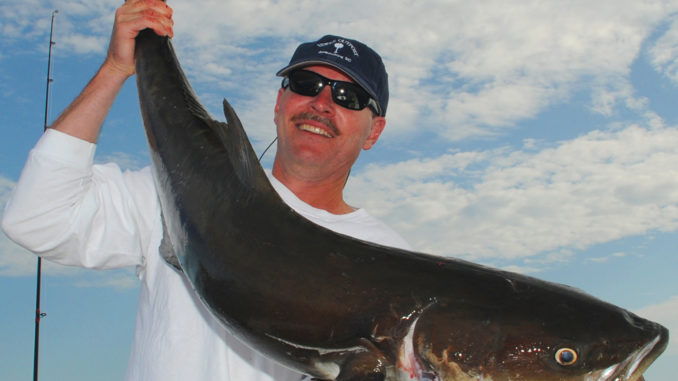
Soaking bait and sight-fishing are great ways to tackle a cobia off North Carolina’s coast this month.
You can’t time it by the tides, the moon, or even the calendar, but as sure as the swallows return to Capistrano, cobia will show up this month from Cape Lookout to Cape Hatteras.
Cobia and North Carolina’s two northernmost capes go together they way a live shrimp and a hungry speckled trout do, and a lot of fishermen can hardly wait for April to give way to May, the estimated time of arrival (ETA) for thousands of cobia making their mysterious northward migration.
“They start to show up around (our) inlets around the last week of April,” said Ronnie Pruitt of Harkers Island Tackle, a veteran cobia fishermen who has access to the ocean through both Beaufort and Barden inlets. “There will be some before that on the offshore reefs, but by May Day, they’ll be moving in, and we’ll get our bigger fish before the end of May.”
Joe Ward of Fly Daddy Charters works the cobia run around Cape Lookout; he calls the second and third week of May the typical peak of the action as the fish move through. “A lot of these fish migrate all the way up from Florida; they go all the way to Chesapeake Bay,” he said.
Pruitt will fish all the way up to Drum Inlet. North of there, guide Ken Dempsey of Hatteras takes over, working the waters often from as far south as Portsmouth Island all the way to Cape Hatteras and Diamond Shoals. He said the first cobia of the year typically show up in big waves along the northern Outer Banks, often pushing along in a slug of beautiful, azure blue water. He said he’ll hear reports of cobia working their way around the Cape Lookout shoals, then to Drum Inlet, then to Portsmouth, Ocracoke and Hatteras inlets and then to Diamond Shoals.
“It seems like they showed up here a little later last year than past years,” Dempsey said. “I can remember Rick Caton (another Hatteras guide) going up to the shoals for 11 straight days and not seeing a fish, then around May 20, he went up and caught 20 in one day.
“It’s typical that they show up in a big wave like that. The weather has got a lot to do with it.”
Few fishermen, guides or even biologists actually understand much about cobia. South Carolina has a study going to track the migration of fish that make the Port Royal Sound between Hilton Head Island and Beaufort the top spot on the entire east coast, and the first indications are that there might be two different groups of fish, separated by genetics. One group stays mostly in the ocean on its northward migration, and the other group will readily move through inlets into sounds and rivers to spawn.
The shoals at both capes can be a huge target for most cobia fishermen because fish tend to concentrate there under certain conditions.
“The shoals seem to be a stopping point for them; the inlets close to the shoals are good, because the shoals will pile up the bait,” Pruitt said. “If we have a warm spell, then a cold front, it will stop the bait migration and they’ll stay awhile.”
Dempsey said that fishing can be hit or miss around Diamond Shoals, depending on currents, wind and water temperature. There are times when the water’s so dingy that even if fish are around, you can’t see them to cast to them. There are times that the warming waters allow cobia to run out about six miles and cut across the shoals, heading north to Oregon Inlet and the Chesapeake Bay. When a cold current runs in north of the shoals, however, Dempsey said that can “trap” cobia on the south side, and he said fishing on the shoals under those conditions “can be like a religious experience,” seeing hundreds of fish, casting to any that are in range, and hooking and landing literally dozens.
“There are so many little variables that affect it,” Dempsey said. “If they stay in that water, you can have tremendous fishing. Sometimes, the water will get a little dingy because of the current and you can’t see them. If you get cold water off the beach, they can go around the corner and head north.”
Most fishermen fall into one or two schools of thought about targeting cobia. The first are the fishermen who cruise likely areas, hoping to spot a cobia traveling at or just below the surface. In clear water, the cobia’s greenish hue is easily seen, even at a distance. Often, having an elevated tower on a boat allows a fisherman to spot them at a greater distance and set up a plan to intercept them. “You’re hunting as much as fishing,” Ward said. “You get the sun at your back and look for fish. If you don’t have the sun at your back, you’re not gonna see anything.”
Second are the fishermen who soak live or cut bait on the bottom in areas regularly used by cobia, who anchor up and wait, often chumming to attract cobia that cross their paths downcurrent. Cobia are primarily bottom-feeders who will prey on anything that gets in their way, but they have a sweet tooth for crabs, as is signified by one of their nicknames: “crab crackers.” Tales are told around marinas and fish houses in the Hatteras area of commercial crabbers finding cobia with their heads wedged into the conical entrance to a crab pot, stuck trying to get to the crabs inside.
Heavier tackle is required to fish on the bottom; fishermen soaking bait often are visited by rays and skates, and it takes a stout rod to budge a big cobia off the bottom of a deep slough. For sight-fishing, most guides recommend a 7-foot spinning outfit that’s rated for 15- to 40-pound line, plus a heavy shock leader. Big bucktails in the 2- to 3-ounce class, with long, soft-plastic trailers, are the most-common baits to cast to cruising cobia, but Ward loves topwater plugs. He said cobia are naturally inquisitive fish, and a big topwater plug splashing across the surface will often irritate them enough to draw a strike.
Fishermen have long looked for cobia under any kind of inshore obstructions, floating or not. Fish that move into inlets are often found around bridge pilings; plenty of fish are seen around channel buoys or crab-pot buoys, and cobia will often swim under a big sea turtle or a big ray that’s cruising under the surface.
Ward said that, like a largemouth bass, a cobia loves “anything that lets them get their eyes in the shade. I’ll always cast to every buoy I see, at least twice. And over the years, I’ve caught a lot of cobia around turtles. You cast toward the turtle and free-line the bait down past them, and they can’t stand it.”
Pruitt said cobia will also swim under big balls of bait, he thinks, for the same reason: shade. “You can cast into the bait balls and feel your jig hitting the bait as it falls,” he said. “I let it fall all the way through them, all the way to the bottom. They won’t hit live bait, but bright colors might excite them.”
Dempsey said that cobia will often cruise at or near the surface above bottom structure in the ocean. Several of his favorite cobia spots out of Hatteras Inlets are “lumps” that rise off the ocean floor.
“I’ve got a couple or three lumps marked on my GPS, between Hatteras Village and the Frisco Pier,” he said. “They’re about three-quarters of a mile apart small lumps where guys used to catch tarpon in the summer. I’ll run a pattern back and forth between those spots, and I know that once we see a cobia on one of those spots, we’ll stay there and catch ‘em the rest of the day.”
Cobia will often move into the Pamlico Sound through Hatteras Inlet, but the “inside” bite doesn’t happen every year, Dempsey said. “The Sloop Channel from Hatteras Inlet to about a half-mile or three-quarters of a mile behind Ocracoke was a hot bite last year,” he said. “The fish stayed there about three or four weeks; we caught four cobia last year flounder fishing, about 25-inch fish. The best fishing back there was when the tide wasn’t running – slack high or slack low. But I stayed away from there if I could; there were too many big rays back there.”
Around Cape Lookout, Pruitt said he’ll set up to bottom-fish for cobia along the edges of deeper channels and put out several baits.
“It’s a lot of work, and it’s nasty, but a lot of people will chum, especially on tide switches,” he said. “Some days, I think chum helps, but some days, I think it attracts things you don’t want, like rays and sharks. But we’ve had some days where we’ve caught five or six cobia chumming when other boats weren’t.”
DESTINATION INFORMATION
HOW TO GET THERE — The Cape Hatteras and Cape Lookout areas hold the two main concentrations of spring cobia. Hatteras is at the southern tip of NC 12, which is accessed from US 64 in Nags Head or US 158 in Kill Devil Hills. A handful of private ramps are available at marinas in Hatteras Village. Cape Lookout is a short boat ride from Harkers Island through Bardens Inlet, or a longer boat ride from the Atlantic Beach/Morehead City area, which is close to the eastern terminus of US 70. Public ramps on the mainland at the bridge to Harkers Island and off US 70 behind the N.C. Department of Marine Fisheries headquarters are popular.
WHEN TO GO — Cobia start showing up in the Cape Lookout area in mid- to late April. Peak fishing is mid-May. It takes several weeks for big waves of cobia to move up the beach to the Ocracoke/Hatteras area, but fish usually arrive there in mid-May, and the bite can last well into June. Cobia are managed with a 2-fish daily creel limit and a 33-inch size minimum (fork length).
TACKLE/TECHNIQUES — Plenty of cobia fishermen soak baits on the bottom in deeper sloughs, hoping cobia will cruise past. Chumming is a big part of bottom-fishing. Sight-fishing is another popular tactic, as anglers look for cruising cobia around buoy markers, bridge pilings, rock jetties and underwater structure in the ocean. Heavy gear is necessary for bottom-fishing, but sight-casters can get by with 7-foot, medium-heavy spinning tackle, a shock leader of fluorocarbon or monofilament and a 2- to 3-ounce bucktail. Cast ahead of a cobia and try to retrieve the bucktail in front if its nose. Cobia often roam in packs, so have a second bait available in case you hook a fish; a second fish following a hooked cobia will often strike at a lure.
GUIDES/FISHING INFO — Ken Dempsey, Ken Dempsey Guide Service, Hatteras, 252-986-2102, www.kendempseyguide.com; Joe Ward, Fly Daddy Charters, 252-229-4656, www.flydaddycharters.com; Ronnie Pruitt, Harkers Island Tackle, 252-838-1126, www.harkersislandtackle.net; Cape Lookout Fly Shop, 252-240-1427, www.capelookoutflyshop.com. See also Guides and Charters in Classifieds.
ACCOMMODATIONS — Hatteras Marlin Motel, Hatteras, 252-986-2141, www.hatterasmarlin.com; Seagull Motel, Hatteras, 252-986-2250, www.seagullhatteras.com; Crystal Coast Tourism Authority, Morehead City, 252-726-8148, www.crystalcoastnc.org.
MAPS — GMCO’s Chartbook of North Carolina, 888-420-6277, www.gmcomaps.com.

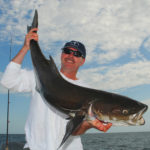
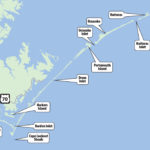
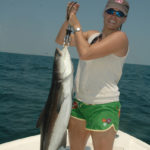
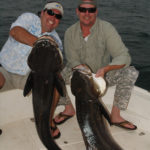



Be the first to comment